#Kandariya Mahadeva Temple is the largest and most ornate Hindu temple in the medieval group found at Khajuraho in Madhya Pradesh
Explore tagged Tumblr posts
Text

#Kandariya Mahadeva Temple is the largest and most ornate Hindu temple in the medieval group found at Khajuraho in Madhya Pradesh#India. Its main tower has 84 mini spires and a definitely impressive fractal-like structure.
1 note
·
View note
Text
Exploring the Historical Treasures of India
India, a land of diverse cultures, languages, and traditions, is a veritable treasure trove of historical wonders. From ancient temples to grand forts, India's historical places offer a glimpse into the rich tapestry of its past. Let's embark on a journey of Historical Places in India, traversing the length and breadth of this ancient land to discover its most enchanting historical places.
1. Taj Mahal, Agra
The Taj Mahal, one of the Seven Wonders of the World, is a symbol of eternal love. Built by Mughal Emperor Shah Jahan in memory of his beloved wife Mumtaz Mahal, this white marble mausoleum stands majestically on the banks of the Yamuna River. Its stunning architecture, intricate inlay work, and lush gardens make it a must-visit destination for travelers from around the globe.
2. Red Fort, Delhi
The Red Fort, a UNESCO World Heritage Site, is a powerful reminder of the Mughal era in India. Constructed by Emperor Shah Jahan in 1648, this red sandstone fort served as the main residence of the Mughal emperors for nearly 200 years. The fort complex is home to several museums, halls, and gardens that showcase Mughal architecture and the grandeur of India's historical past.
3. Qutub Minar, Delhi
Standing tall at 73 meters, Qutub Minar is the tallest brick minaret in the world and a fine example of Indo-Islamic architecture. Commissioned by Qutb-ud-din Aibak in 1192, this UNESCO World Heritage Site marks the beginning of Muslim rule in India. The minaret is surrounded by several other historically significant structures, including the Quwwat-ul-Islam Mosque and the Iron Pillar, known for its rust-resistant composition.
4. Amber Fort, Jaipur
Perched on a hilltop overlooking the Maota Lake, Amber Fort is a splendid blend of Hindu and Mughal architectural styles. Built by Raja Man Singh in the 16th century, the fort's intricate mirror work, ornate halls, and stunning courtyards make it one of the most visited historical places in Rajasthan. The fort's Sheesh Mahal (Mirror Palace) is particularly famous for its exquisite mirror mosaics and colored glasses.
5. Mysore Palace, Mysore
The Mysore Palace, also known as the Amba Vilas Palace, is a spectacular example of Indo-Saracenic architecture. It was the royal residence of the Wadiyar dynasty and is renowned for its grand durbar hall, intricate carvings, and beautifully painted ceilings. The palace is illuminated with nearly 100,000 light bulbs during the Dussehra festival, creating a breathtaking spectacle.
6. Khajuraho Temples, Madhya Pradesh
The Khajuraho Group of Monuments, a UNESCO World Heritage Site, is famed for its stunningly intricate temples adorned with erotic sculptures. Built between 950 and 1050 AD by the Chandela dynasty, these temples celebrate various aspects of life, including love and spirituality. The temples are divided into three groups: Western, Eastern, and Southern, with the Kandariya Mahadeva Temple being the largest and most ornate.
7. Hampi, Karnataka
Hampi, a UNESCO World Heritage Site, was once the capital of the Vijayanagara Empire. Its ruins are spread over a vast area, offering a glimpse into the grandeur of this medieval city. The Virupaksha Temple, Vittala Temple with its iconic stone chariot, and the Lotus Mahal are among the highlights of Hampi. The site is a paradise for history buffs and architecture enthusiasts.
8. Ajanta and Ellora Caves, Maharashtra
The Ajanta and Ellora Caves are among the finest examples of ancient rock-cut architecture in India. The Ajanta Caves, dating back to the 2nd century BCE, are renowned for their exquisite Buddhist murals and sculptures. The Ellora Caves, a mix of Buddhist, Hindu, and Jain temples, were carved between the 6th and 10th centuries CE. The Kailasa temple at Ellora is particularly noteworthy for its massive size and intricate carvings.
9. Sanchi Stupa, Madhya Pradesh
The Sanchi Stupa is one of the oldest stone structures in India and an important Buddhist pilgrimage site. Commissioned by Emperor Ashoka in the 3rd century BCE, the stupa's hemispherical dome houses relics of the Buddha. The ornate gateways (toranas) around the stupa depict scenes from the Buddha's life and the Jataka tales, offering insight into early Buddhist art and architecture. historical places in India not only serve as repositories of the past but also as a source of inspiration, offering a glimpse into the rich tapestry of the country's heritage
10. Jaisalmer Fort, Rajasthan
Known as the "Golden Fort" due to its yellow sandstone walls that shine brilliantly in the sunlight, Jaisalmer Fort is a living fort with a vibrant community residing within its walls. Built in 1156 by Rawal Jaisal, the fort's massive ramparts, intricately carved Jain temples, and the Maharaja's palace make it a fascinating historical site. The fort offers panoramic views of the surrounding Thar Desert.
Conclusion
historical places in India are not just remnants of the past; they are living testaments to the country's rich cultural heritage and architectural prowess. Each site has a unique story to tell, reflecting the diverse history and traditions that have shaped India over millennia. Exploring these historical treasures offers an unparalleled journey through time, allowing visitors to connect with the soul of India.
0 notes
Photo

by AnatolyBerman
The Kandariya Mahadeva Temple meaning “the Great God of the Cave”, is the largest and most ornate Hindu temple in the medieval temple group found at Khajuraho in Madhya Pradesh, India. …
34 notes
·
View notes
Photo

Kandariya Mahadeva Temple The Kandariya Mahadeva Temple (Devanagari: कंदारिया महादेव मंदिर, Kandāriyā Mahādeva Mandir), meaning "the Great God of the Cave", is the largest and most ornate Hindu temple in the medieval temple group found at Khajuraho in Madhya Pradesh, India. It is considered one of the best examples of temples preserved from the medieval period in India. (at India : इंडिया) https://www.instagram.com/p/CkUL2kSswSe/?igshid=NGJjMDIxMWI=
0 notes
Text

The Kandariya Mahadeva Temple, meaning the Great God of the Cave, is the largest and most ornate Hindu temple in the medieval temple group found at Khajuraho in Madhya Pradesh, India.
1 note
·
View note
Photo
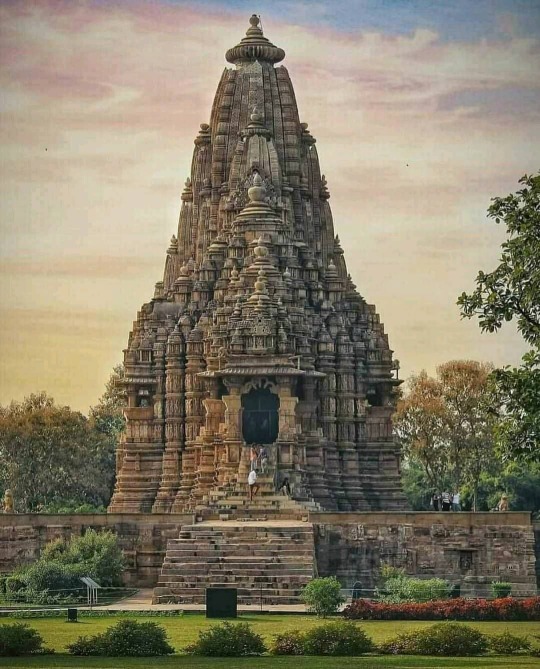
🕉️🚩🛕🇮🇳⠀ ⠀ The Kandariya Mahadeva Temple, meaning "the Great God of the Cave", is the largest & most ornate Hindu temple in the medieval temple group found at Khajuraho in Madhya Pradesh, India. It is considered one of the best examples of temples preserved from the medieval period in India.⠀ ⠀ Khajuraho was once the capital of the Chandela dynasty. The Kandariya Mahadeva Temple,one of the best examples of temples preserved from the medieval period in India, is the largest of the western group of temples in the Khajuraho complex which was built by the Chandela rulers. Shiva, the chief deity in the temple deified in the sanctum sanctorum.⠀ ⠀ The Kandariya Mahadeva temple was built during the reign of Vidyadhara (r. c. 1003-1035 CE). Vidhyadhara, also known as Bida in the recordings of the Muslim historian Ibn-al-Athir was a powerful ruler who fought Mahmud of Ghazni in the first offensive launched by the latter in 1019. This battle was not conclusive and Mahmud had to return to Ghazni. Mahmud again waged war against Vidhyadhara in 1022. He attacked the fort of Kalinjar. The siege of the fort was unsuccessful. It was lifted and Mahmud and Vidhyadhara called a truce & parted by exchanging gifts. Vidhyadhara celebrated his success over Mahmud and other rulers by building the Kaṇḍāriyā Mahādeva Temple, dedicated to his family deity Shiva.⠀ ⠀ The Kandariya Mahadeva Temple, in the western complex is 102 ft in height. This western group of temples, consisting of the Kandariya, Matangeshwara and Vishvanatha temples, is compared to a "cosmic design of a hexagon (a yantra or Cosmo gram)" representing the three forms of Shiva. The temple architecture is an assemblage of porches and towers which terminates in a shikhara or spire, a feature common from the 10th century onwards in the temples of Central India.⠀ ⠀ All the extant temples including the Kandariya Mahadeva Temple were inscribed in 1986 under the UNESCO List of World Heritage Sites under Criterion III for its artistic creation & under Criterion V for the culture of the Chandelas that was popular till the country was invaded by Muslims in 1202.⠀ ⠀ ⠀ Feel 🆓 to share and bookmark 🔖 ⠀ ⠀ 📸 DM for credits ⠀ ⠀ ⠀ (at Kandariya Mahadeva Temple) https://www.instagram.com/p/CFEmBbkFEp0/?igshid=3wvlfl8x4k3h
0 notes
Photo

The Kandariya Mahadeva Temple, meaning "the Great God of the Cave", is the largest and most ornate Hindu temple in the medieval temple group found at Khajuraho in Madhya Pradesh, India. It is considered one of the best examples of temples preserved from the medieval period in India. https://www.instagram.com/p/B_o-bpVFBJq/?igshid=yfyb0lbt1qhh
0 notes
Text
Famous Old Heritage city Khajuraho, Madhya Pradesh
The Khajuraho Group of Monuments is a group of Hindu temples and Jain temples in Chhatarpur, Madhya Pradesh, India, about 175 kilometers southeast of Jhansi. They are one of the UNESCO World Heritage Sites in India. The temples are famous for their nagara-style architectural symbolism and their erotic sculptures
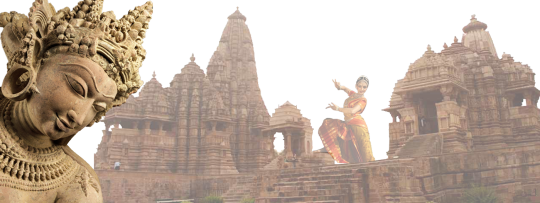
The Kandariya Mahadeva Temple, meaning "the Great God of the Cave", is the largest and most ornate Hindu temple in the medieval temple group found at Khajuraho in Madhya Pradesh, India. It is considered one of the best examples of temples preserved from the medieval period in India
The Lakshmana Temple is a 10th-century Hindu temple built by Yasovarman located in Khajuraho, India. Dedicated to Vaikuntha Vishnu - an aspect of Vishnu.
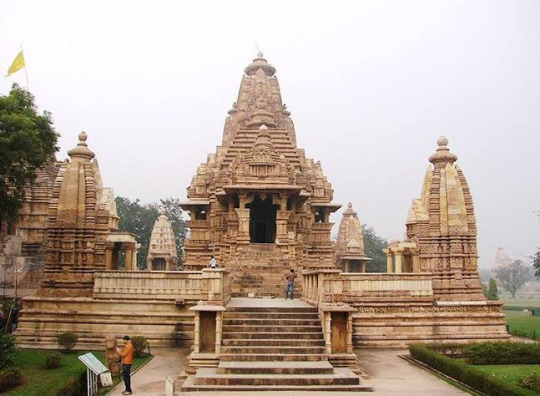
The Duladeo Temple is a Hindu temple in Khajuraho, Madhya Pradesh, India. The temple is dedicated to the god Shiva in the form of a linga, which is deified in the sanctum. 'Dulodeo' means "Holy Bridegroom". The temple is also known as "Kunwar Math". The temple faces east and is dated to 1000–1150 AD.
The Khajuraho group of monuments was built during the rule of the Chandela dynasty. The building activity started almost immediately after the rise of their power, throughout their kingdom to be later known as Bundelkhand. Most temples were built during the reigns of the Hindu kings Yasovarman and Dhanga. Yasovarman legacy is best exhibited by the Lakshmana Temple. Vishvanatha temple best highlights King Dhanga's reign. The largest and currently most famous surviving temple is Kandariya Mahadeva built in the reign of King Vidyadhara.[ The temple inscriptions suggest many of the currently surviving temples were complete between 970 and 1030 CE, with further temples completed during the following decades.
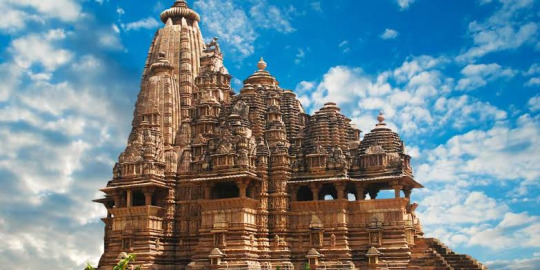
The Khajuraho temples were built about 35 miles from the medieval city of Mahoba, the capital of the Chandela dynasty, in the Kalinjar region. In ancient and medieval literature, their kingdom has been referred to as Jijhoti, Jejahoti, Chih-chi-to and Jejakabhukti.
visit :- https://www.rajasthantourplanner.com/khajuraho-tour-planner/index.html
#KhajurahoTourPackages#KhajurahoheritageTours#KhajurahoBudgetTours#The Khajuraho Group of Monuments#KhajurahoTourism
0 notes
Text
Places To Visit In Khajuraho || Khajuraho Tour Planner
Khajuraho Madhya Pradesh :-
The Khajuraho Group of Monuments is a group of Hindu, Buddhist and Jain temples in Madhya Pradesh, India, about 175 kilometres (109 mi) southeast of Jhansi. They are one of the UNESCO World Heritage Sites in India. The temples are famous for their nagara-style architectural symbolism and their erotic sculptures.
Most Khajuraho temples were built between 950 and 1050 by the Chandela Rajput dynasty. Historical records note that the Khajuraho temple site had 85 temples by the 12th century, spread over 20 square kilometers Of these, only about 25 temples have survived, spread over 6 square kilometers. Of the various surviving temples, the Kandariya Mahadeva Temple is decorated with a profusion of sculptures with intricate details, symbolism and expressiveness of ancient Indian art.

The Khajuraho group of temples were built together but were dedicated to two religions, Hinduism and Jainism, suggesting a tradition of acceptance and respect for diverse religious views among Hindus and Jains in the region.
Khajuraho History :-
The Hindu and Jain temple complex at Khajuraho in central India has become a major tourist site for Indians and International tourist. Built nearly a thousand years ago, but abandoned two centuries later, Khajuraho remained a minor pilgrimage site into the present century. The Khajuraho temples include thousands of sexual relief carvings, much publicized throughout India. Khajuraho temples were built during the Chandela period, a dynasty which survived for five centuries before falling to the onslaught of Islam. The history tells us that in the ancient India, the kings did not sponsor directly the making of rock-cut caves, stupas or temples. None of the stupas have sculptures of the Kings and rulers of those times. But with the arrival of the medieval period, rulers began to patronize personally the making of temples.

The personal attention of the ruler led to the making of the larger temples, especially from the 10th or 11th century onwards, under the Cholas in south India. Similarly changes were seen under the rule of the Chandela in the central India. Chandela dynasty was well established and there was peace and prosperity in 10th and 11th century. Art and culture flourished there as the kings were great patrons of poetry and theatre. The symbol of their cultural achievements was at their capital city of Khajuraho, where between the 10th and 12th centuries, one of the most splendid temple cities in the history of the world was created. There were originally 85 temples were created out of which only 22 are remain today. The first king who started construction in Khajuraho was Harsh who built the 64 Yogini Temples. The most notable prince of this dynasty was King Dhanga whose time is known for building the most beautiful Khajuraho Temples of Parsvanath and Vishwavanath. His grandson Vidyadhara built the Kandariya Mahadev Temple. This was the golden era of central India. Most of the Khajuraho Temples at Khajuraho were constructed between 950 AD and 1050 AD and are either Hindu or Jain.
The Kandariya Mahadeva temple built in the early 11th century and dedicated to Shiva. The Lakhmana temple was built in 954 AD by King Dhanga to celebrate independence from the Gurjara Pratihara rulers. The Lakhmana Temple was dedicated to Vishnu. By the time of Chandela, the Indian temples form had fully developed. The objective of the temple was that a devotee comes to it with the aspiration of the self transcendence and to receive the grace of the deity in the garbha griha. The devotees came to the temple to awaken within themselves and to realize the whole creation of the world is the manifestation of the deity in the garbha griha. Some believe that the erotic art suggest the sexual practices. Its noted that only ten percent of the carvings contain errotic themes and rest of the sculptures depict the everyday life of the common persons such as women putting on makeup, playing games, dancing, knotting and unknotting their girdles, and other themes such as musicians, potters, farmers etc. On the temple walls, one can see Siva, Vishnu, Brahma, Indira, Agni and their spouses.

Places To Visit In Khajuraho :–
Kandariya Mahadev Temple -
The Kandariya Mahadeva Temple, meaning "the Great God of the Cave", is the largest and most ornate Hindu temple in the medieval temple group found at Khajuraho in Madhya Pradesh, India. It is considered one of the best examples of temples preserved from the medieval period in India.
Chausath Yogini temple – The Chausath Yogini temple is a ruined Devi temple in the Khajuraho town of Madhya Pradesh, India. Dated to the late 9th century, it is the oldest surviving temple at Khajuraho. Unlike the Chausath Yogini temples at other places, it has a rectangular plan.

Laxmi Temple –
Lakshmi temple is dedicated to Goddess Lakshmi, consort of Lord Vishnu. This structure is one of the monument among Khajuraho Group of Monuments, a World Heritage Site in India
Visvanatha Temple –
The Vishvanatha Temple is a Hindu temple in Madhya Pradesh, India. It is located among the western group of Khajuraho Monuments, a UNESCO World Heritage site. The temple is dedicated to Shiva, who is also known as "Vishvanatha", meaning "Lord of the Universe".
0 notes
Text
Famous Monuments In Khajuraho - Khajuraho Tourism
Khajuraho Tourism –
The Khajuraho Group of Monuments is a group of Hindu and Jain temples in Chhatarpur, Madhya Pradesh, India, about 175 kilometres (109 mi) southeast of Jhansi. They are one of the UNESCO World Heritage Sites in India. The temples are famous for their nagara-style architectural symbolism and their erotic sculptures. Most Khajuraho temples were built between 950 and 1050 by the Chandela dynasty. Historical records note that the Khajuraho temple site had 85 temples by the 12th century, spread over 20 square kilometers Of these, only about 25 temples have survived, spread over 6 square kilometers. Of the various surviving temples, the Kandariya Mahadeva Temple is decorated with a profusion of sculptures with intricate details, symbolism and expressiveness of ancient Indian art. The Khajuraho group of temples were built together but were dedicated to two religions, Hinduism and Jainism, suggesting a tradition of acceptance and respect for diverse religious views among Hindus and Jains in the region
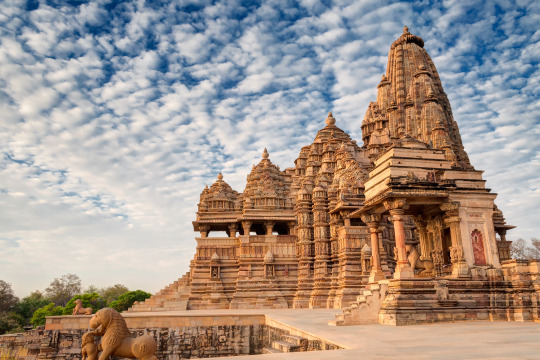
KHAJURAHO HISTORY -
The Hindu and Jain temple complex at Khajuraho in central India has become a major tourist site for Indians and International tourist. Built nearly a thousand years ago, but abandoned two centuries later, Khajuraho remained a minor pilgrimage site into the present century. The Khajuraho temples include thousands of sexual relief carvings, much publicized throughout India. Khajuraho temples were built during the Chandela period, a dynasty which survived for five centuries before falling to the onslaught of Islam. The history tells us that in the ancient India, the kings did not sponsor directly the making of rock-cut caves, stupas or temples. None of the stupas have sculptures of the Kings and rulers of those times. But with the arrival of the medieval period, rulers began to patronize personally the making of temples.
The personal attention of the ruler led to the making of the larger temples, especially from the 10th or 11th century onwards, under the Cholas in south India. Similarly changes were seen under the rule of the Chandela in the central India. Chandela dynasty was well established and there was peace and prosperity in 10th and 11th century. Art and culture flourished there as the kings were great patrons of poetry and theatre. The symbol of their cultural achievements was at their capital city of Khajuraho, where between the 10th and 12th centuries, one of the most splendid temple cities in the history of the world was created. There were originally 85 temples were created out of which only 22 are remain today. The first king who started construction in Khajuraho was Harsh who built the 64 Yogini Temples.
Places To Visit In Khajuraho
Kandariya Mahadev Temple- Kandariya Mahadev Temple This is without any doubt the largest and most magnificent temple in Khajuraho. The elegant proportions of this building and its sculptural detailing are the most refined examples of this artistice heritage of central India. Kandariya Mahadev shares its high platform with the small Mahadev shrine and the medium - sized Devi jagdambi Temple, thereby accentuating its height and grandeur. As far as we know, after the Kandariya Mahaddev temple, the artist of khajuraho never again attempted to build a strcuture so high or ornate. The temple measures about 30 metres in lenght and 20 m width. The temple shikhara rises 35.3 metres in length.
The temple shikhara rises 35.3 Detres above the ground. from the east side it looks like a huge mountain of stone with a dark cave-like opening set high above the ground. The temple measures about 30 metres in length and cave-like opening Set high above the ground. The name Kandaya Mahadev refers also to Shiva, the ascetic who dwells in a mountain cave, lost in meditation. In profile the pyramidal porch, mandap roofs and conical shikhara looks like a range of mountain staraining upwards till it meets the sky, or shiva. The shikhara of the kandariya Mahadev Temples is borad at the base and in graceful curve grow narrower as it reaches the pinnacle. It is built up of over righty replica shikharas that appear to be clambering up the central tower, giving it bothe force and momnetum on its skyward journey towards divinity.
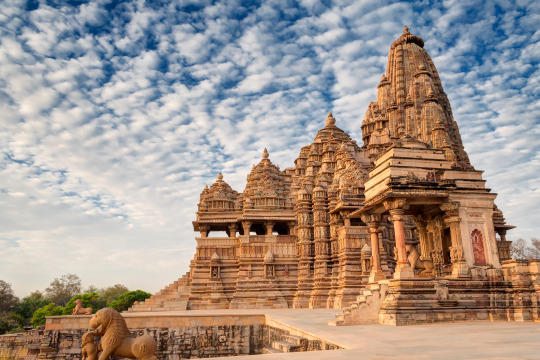
Lakshmana Temple - Lakshmana temple, dedicated to Lord Vishnu, was built from 930-950 AD during the reign of King Yasovarman of the Chandella kingdom. It houses a sacred image of Vaikuntha-Vishnu brought from Tibet. Though the temple is one of the oldest in the Khajuraho fields, it is also one of the most exquistely decorated, covered almost completely with images of over 600 gods in the Hindu Pantheon. The main shrine of the temple, which faces east, is flanked by four freestanding subsidiary shrines at the corners of the temple platform. The temple is famous for the explicitely sexual carvings on the southern side of the temple (images 12-13), though these make up only a small fraction of the total.
The lakshman Temple stands like a gaint mountain of stone at the centre, and is unique in khajuraho for its four subsidiary shrines at the four corners of its rectangular platform. Each Subsidairy shrine has a little porch, band of scultpure along the esterior walls. Once gain you must walk in pradakshina around the Lakshman Temple to see the abundance of sculptural masterpieces on its outer walls. Starting on the south side you will see that the exterior temple wall is divided into several bands, the lowest, the adhishthana, is the base of the temple. The Lakshan Temple is the only one with a row of elephants that peep out of the base as if they are carrying the weight of the stone universe on their stable shoulders. Between the elephants are warriors protecting the temple: on the north side one elephant has forsaken his duty and naughtily gazes at s couple making love. Above the elephants, the moulded adhishthana has flower and leaf motifs, a narrow panel depicting court life and erotic scenes.

Matangeshwar Temple- Matangeshwar Temple is a ninth century temple and a famous temple in Madhya Pradesh. Chandra Dev of the Chandela dynasty built the temple. The king was a devotee of lord Shiva. Lord Shiva is considered as the venerated sage Matang and that’s how the name of the Shiva Lingam was Matangeswarar.
The Matangeshwar Temple is a larger-scale version of the Brahma Temple in terms of plan and design. It has a square plan. Also known as Mrityunjaya Mahadeo Temple, the exterior and interior of this temple is not decorated with sculptures like other Khajuraho Temples but the ceiling is overlapped with sculptures. There is an open air archaeological museum to the south of the temple that has a vast collection of statues and friezes.

Adinath Temple – The Adinatha Temple, standing immediately to the north of the Parsvanath, is an important constituent of the Jain group of Khajuraho temples. It is a temple without ambulatory, of which only the sanctum and vestibule have survived with their roofs. Its ‘mandapa’ and entrance porch are lost and replaced by a modern entrance chamber, made of lime-plastered masonry, showing arched doorways, which is quite incongruous with the original structure
The temple is 'sapta-ratha' on plan as well as in elevation with mono-spired 'sikhara' of graceful outline. In the elegance of sculptural style as well as in general plan and design, this temple , dedicated to first Jain Tirthankara, Adinath, bears the closest kinship to the Vamana Temple.The smartness of her body and te restlessness of her feet, the vigorous, dynamic movement all have been so aptly carved out.

Ajaigarh Fort – Jaigarh and Kalinjar are two forts located at 80 kms and 100 kms respectively from Khajuraho. Ajaigarh is located in the Panna district and Kalinjar fort in the border between Uttar Pradesh and M.P. Ajaigarh Fort originally had five gates, but now has two gates, two temples and two rock-cut tanks inside it. Three ruined Jain temples built in Khajuraho style also have been traced in Ajaigarh fort.
There is plenty to explore in the fort, which makes it a treat for history lovers. Ajaigarh Fort originally had five gates, but now only two gates are survived. There are two temples and two rock-cut tanks present inside the fort. These tanks have been named as Ganga and Yamuna. Close to it is a ruined Chandela temple, dedicated to Raja Parmardi deva. Three ruined Jain temples built in Khajuraho style have been traced here. The fort walls have been constructed with large, dressed, stones and no visible mortar.
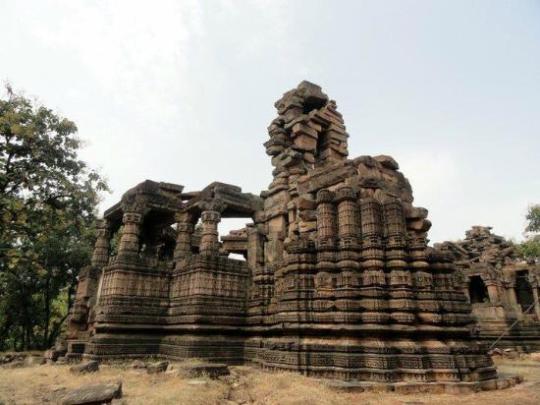
Jain Museum - Jain Museum is a complex dedicated to the preservation and display of Jain sculptures. It was opened for display in the year 1987. It is located within the premises of the Jain Temple. The circular building of the museum is also known as Sahu Shantiprasad Jain Kala Sangrahalaya among the locals.
Khajuraho has three museums in the vicinity of the temples in Khajuraho. A.S.I maintains the arcaeological museum near the Matangeshwar temple in the western group of temples, Adivart Tribal and Folk Art Museum is in the Chandela Cultural Complex and Sahu Shantiprasad Jain Kala Sangrahalaya is near the eastern group of temples. Dhubela Museum is on the Jhansi - Khajuraho road and houses artefacts related to Bundela Dynasty.

0 notes
Text
Famous Old Heritage city Khajuraho in Madhya Pradesh
Famous Old Heritage city Khajuraho in Madhya Pradesh
The Khajuraho Group of Monuments is a group of Hindu temples and Jain temples in Chhatarpur, Madhya Pradesh, India, about 175 kilometers southeast of Jhansi. They are one of the UNESCO World Heritage Sites in India. The temples are famous for their nagara-style architectural symbolism and their erotic sculptures The Kandariya Mahadeva Temple, meaning "the Great God of the Cave", is the largest and most ornate Hindu temple in the medieval temple group found at Khajuraho in Madhya Pradesh, India. It is considered one of the best examples of temples preserved from the medieval period in India The Lakshmana Temple is a 10th-century Hindu temple built by Yashovarman located in Khajuraho, India. Dedicated to Vaikuntha Vishnu - an aspect of Vishnu.
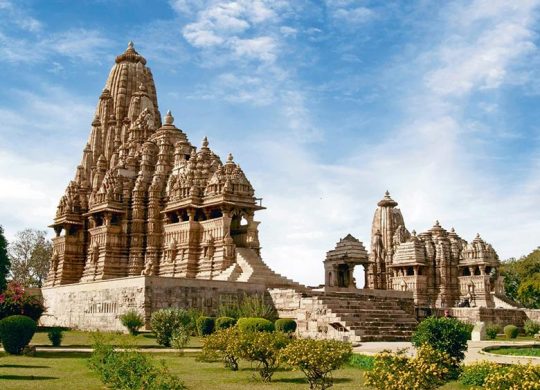
The Duladeo Temple is a Hindu temple in Khajuraho, Madhya Pradesh, India. The temple is dedicated to the god Shiva in the form of a linga, which is deified in the sanctum. 'Dulodeo' means "Holy Bridegroom". The temple is also known as "Kunwar Math". The temple faces east and is dated to 1000–1150 AD. The Khajuraho group of monuments was built during the rule of the Chandela dynasty. The building activity started almost immediately after the rise of their power, throughout their kingdom to be later known as Bundelkhand. Most temples were built during the reigns of the Hindu kings Yashovarman and Dhanga. Yashovarman's legacy is best exhibited by the Lakshmana Temple. Vishvanatha temple best highlights King Dhanga's reign. The largest and currently most famous surviving temple is Kandariya Mahadeva built in the reign of King Vidyadhara.[ The temple inscriptions suggest many of the currently surviving temples were complete between 970 and 1030 CE, with further temples completed during the following decades.
The Khajuraho temples were built about 35 miles from the medieval city of Mahoba, the capital of the Chandela dynasty, in the Kalinjar region. In ancient and medieval literature, their kingdom has been referred to as Jijhoti, Jejahoti, Chih-chi-to and Jejakabhukti.
#Carrentalkhajuraho #Indiatourism #Travelindia #Indiacarhire
0 notes
Photo
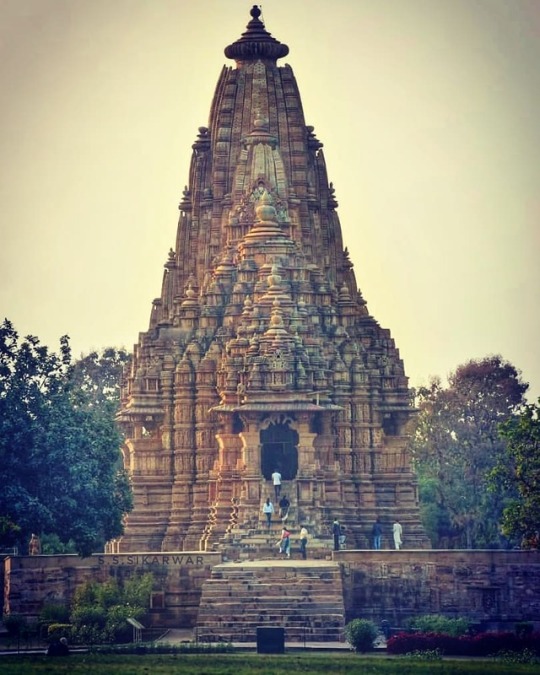
Kandariya Mahadeva Temple is the largest, tallest and most beautiful Hindu Temple of the Khajuraho Group of Temples. This medieval marvel dates back to 1050 BC and was built by Chandela ruler. The temple is embellished with ornate carvings and sculptures. Its main spire depicts Mount Kailash and stands with a height of 31 meters. Surrounding this spire are other 84 miniature spires. This temple is dedicated to Hindu Lord Shiva, and has a Shiva Linga made of marbel, as its sanctum. https://www.instagram.com/p/Brr13wLHBTf/?utm_source=ig_tumblr_share&igshid=1h7wjqiwug9mm
0 notes
Photo
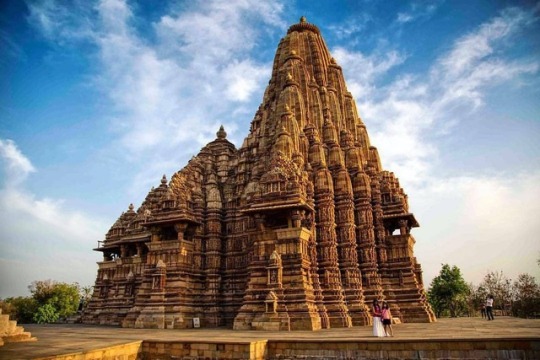
The Kandariya Mahadeva Temple meaning "the Great God of the Cave", is the largest and most ornate Hindu temple in the medieval temple group found at Khajuraho in Madhya Pradesh, India. It is considered one of the best examples of temples preserved from the medieval period in India. Kaṇḍāriyā Mahādeva Temple is located in the Chhatarpur district of Madhya Pradesh in Central India. It is in the Khajuraho village, and the temple complex is spread over an area of 6 square kilometres (2.3 sq mi). It is in the western part of the village to the west of the Vishnu temple.
0 notes
Photo
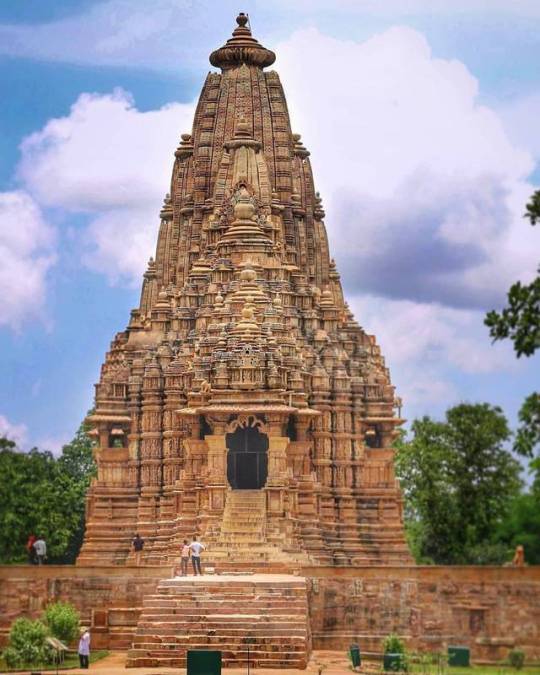
The Kandariya Mahadeva Temple, meaning "the Great God of the Cave", is the largest and most ornate Hindu temple in the medieval temple group found at Khajuraho in Madhya Pradesh, India. Khajuraho was once the capital of the Chandela dynasty. The Kandariya Mahadeva Temple, one of the best examples of temples preserved from the medieval period in India, is the largest of the western group of temples in the Khajuraho complex which was built by the Chandela rulers. Shiva is the chief deity in the temple deified in the sanctum sanctorium. The Kandariya Mahadeva temple was built during the reign of Vidyadhara (r. c. 1003-1035 CE). At various periods of the reign of this dynasty many famous temples dedicated to Vishnu, Shiva, Surya, Shakti of the Hindu religion and also for the Thirthankaras of Jain religion were built.
0 notes